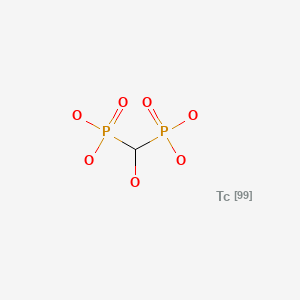Attribution Statement: LactMed is a registered trademark of the U.S. Department of Health and Human Services.
NCBI Bookshelf. A service of the National Library of Medicine, National Institutes of Health.
Drugs and Lactation Database (LactMed®) [Internet]. Bethesda (MD): National Institute of Child Health and Human Development; 2006-.
CASRN: 72945-61-0

Drug Levels and Effects
Summary of Use during Lactation
Information in this record refers to the use of oxidronic acid 99mTc-complex (Tc99m-hydroxymethylene diphosphonate; Tc99m-HDP) as a diagnostic agent. A US Nuclear Regulatory Commission subcommittee has recommended that nursing be discontinued for 24 hours after administration of all technetium Tc 99m diagnostic products to simplify guidance recommendations, although this time interval may be longer than necessary.[1] Other sources state that breastfeeding need not be interrupted after administration of Tc 99m HDP to nursing mothers.[2] However, to follow the principle of keeping exposure "as low as reasonably achievable", some experts recommend nursing the infant just before administration of the radiopharmaceutical and interrupting breastfeeding for 3 to 6 hours after the dose, then expressing the milk completely once and discarding it or store it for at least 60 hours (10 half-lives) before giving it to the infant. If the mother has expressed and saved milk prior to the examination, she can feed it to the infant during the period of nursing interruption.[2-5]
Mothers concerned about the level of radioactivity in their milk could ask to have it tested at a nuclear medicine facility at their hospital. When the radioactivity is at a safe level, she may resume breastfeeding. A method for measuring milk radioactivity and determining the time when a mother can safely resume breastfeeding has been published.[6]
For nursing mothers who work with Tc 99m substances in their workplace, there is no need to take any precautions other than those appropriate for general radiation protection.[7]
Drug Levels
Tc 99m is a gamma emitter with a principal photon energy of 140 keV and a physical half-life of 6.04 hours.[1] The effective half-life of Tc 99m HDP is 5.1 hours.[2]
Effects in Breastfed Infants
Relevant published information was not found as of the revision date.
Effects on Lactation and Breastmilk
Relevant published information was not found as of the revision date.
References
- 1.
- Dilsizian V, Metter D, Palestro C, Zanzonico P. Advisory Committee on Medical Uses of Isotopes (ACMUI) Sub-Committee on Nursing Mother Guidelines for the Medical Administration of Radioactive Material. Final report submitted: January 31, 2019. 2019. https://www
.nrc.gov/docs /ML1903/ML19038A498.pdf - 2.
- Mountford PJ, Coakley AJ. A review of the secretion of radioactivity in human breast milk: Data, quantitative analysis and recommendations. Nucl Med Commun 1989;10:15-27. [PubMed: 2645546]
- 3.
- Early PJ, Sodee DB. Principles and practice of nuclear medicine. 2nd ed. St Louis Mosby-Year Book, Inc 1995:1380-1.
- 4.
- International Atomic Energy Agency. Radiation Protection and Safety in Medical Uses of Ionizing Radiation, IAEA Safety Standards Series No. SSG-46, IAEA, Vienna. 2018. https://www
.iaea.org /publications/11102/radiation-protection-and-safety-in-medical-uses-of-ionizing-radiation - 5.
- ARSAC notes for guidance: Good clinical practice in nuclear medicine. Notes for guidance on the clinical administration of radiopharmaceuticals and use of sealed radioactive sources. 2020. https://www
.gov.uk/government /publications /arsac-notes-for-guidance [PubMed: 10732169] - 6.
- Stabin MG, Breitz HB. Breast milk excretion of radiopharmaceuticals: Mechanisms, findings, and radiation dosimetry. J Nucl Med 2000;41:863-73. [PubMed: 10809203]
- 7.
- Almén A, Mattsson S. Radiological protection of foetuses and breast-fed children of occupationally exposed women in nuclear medicine - Challenges for hospitals. Phys Med 2017;43:172-7. [PubMed: 28882410]
Substance Identification
Substance Name
Oxidronic Acid 99mTc-Complex
CAS Registry Number
72945-61-0
Drug Class
Breast Feeding
Milk, Human
Radiopharmaceuticals
Technetium Compounds
Diagnostic Agents
Disclaimer: Information presented in this database is not meant as a substitute for professional judgment. You should consult your healthcare provider for breastfeeding advice related to your particular situation. The U.S. government does not warrant or assume any liability or responsibility for the accuracy or completeness of the information on this Site.
- User and Medical Advice Disclaimer
- Drugs and Lactation Database (LactMed) - Record Format
- LactMed - Database Creation and Peer Review Process
- Fact Sheet. Drugs and Lactation Database (LactMed)
- Drugs and Lactation Database (LactMed) - Glossary
- LactMed Selected References
- Drugs and Lactation Database (LactMed) - About Dietary Supplements
- Breastfeeding Links
- PubChem SubstanceRelated PubChem Substances
- PubMedLinks to PubMed
- Review Technetium Tc 99m Gluconate.[Drugs and Lactation Database (...]Review Technetium Tc 99m Gluconate.. Drugs and Lactation Database (LactMed®). 2006
- Review Technetium Tc 99m Tetrofosmin.[Drugs and Lactation Database (...]Review Technetium Tc 99m Tetrofosmin.. Drugs and Lactation Database (LactMed®). 2006
- Review Technetium Tc 99m Sestamibi.[Drugs and Lactation Database (...]Review Technetium Tc 99m Sestamibi.. Drugs and Lactation Database (LactMed®). 2006
- Review Technetium Tc 99m Glucoheptonate.[Drugs and Lactation Database (...]Review Technetium Tc 99m Glucoheptonate.. Drugs and Lactation Database (LactMed®). 2006
- Review Technetium Tc 99m Medronate.[Drugs and Lactation Database (...]Review Technetium Tc 99m Medronate.. Drugs and Lactation Database (LactMed®). 2006
- Oxidronic Acid 99mTc-Complex - Drugs and Lactation Database (LactMed®)Oxidronic Acid 99mTc-Complex - Drugs and Lactation Database (LactMed®)
Your browsing activity is empty.
Activity recording is turned off.
See more...
